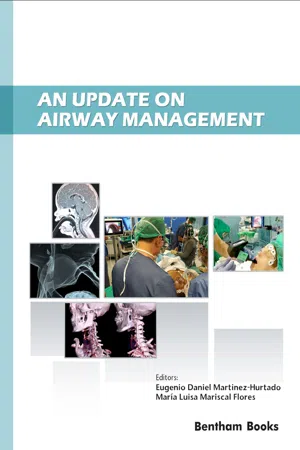
An Update on Airway Management
Eugenio Daniel Martinez-Hurtado, María Luisa Mariscal Flores
- English
- ePUB (mobile friendly)
- Available on iOS & Android
An Update on Airway Management
Eugenio Daniel Martinez-Hurtado, María Luisa Mariscal Flores
About This Book
In recent years, there have been many advances in the safe management of the patient's airway, a cornerstone of anesthetic practice. An Update on Airway Management brings forth information about new approaches in airway management in many clinical settings. This volume analyzes and explains new preoperative diagnostic methods, algorithms, intubation devices, extubation procedures, novelties in postoperative management in resuscitation and intensive care units, while providing a simple, accessible and applicable reading experience that helps medical practitioners in daily practice. The comprehensive updates presented in this volume make this a useful reference for anesthesiologists, surgeons and EMTs at all levels. Key topics reviewed in this reference include:· New airway devices, clinical management techniques, pharmacology updates (ASA guidelines, DAS algorithms, Vortex approach, etc.), · Induced and awake approaches in different settings· Updates on diagnostic accuracy of perioperative radiology and ultrasonography· Airway management in different settings (nonoperating room locations and emergency rooms)· Airway management in specific patient groups (for example, patients suffering from morbid obesity, obstetric patients and critical patients)· Algorithms and traditional surgical techniques that include emergency cricothyrotomy and tracheostomy in 'Cannot Intubate, Cannot Ventilate' scenarios.· Learning techniques to manage airways correctly, focusing on the combination of knowledge, technical abilities, decision making, communication skills and leadership· Special topics such as, difficult airway management registry, organization, documentation, dissemination of critical information, big data and databases
Frequently asked questions
Information
An Update on Paediatric Airway Management
Gema Pino Sanz1, *, María Dolores Méndez Marín1
Abstract
* Corresponding author Gema Pino Sanz: Department of Pediatric Anesthesiology, Hospital Universitario Doce De Octubre, Madrid, Spain; Tel/Fax:0034 913 90 80 00; E-mail:[email protected]
AIRWAY ANATOMY
AIRWAY PHYSIOLOGY
| Anatomy | Implication | Management |
|---|---|---|
| Prominent occiput Nares small Neck short Lymphoid tissue | Neck flexed in supine position Upper airway obstruction Oral/pharyngeal/laryngeal axes not lined up Laryngoscopy difficult | Shoulder roll Sniff position |
| Cephalad larynx Large tongue to mouth size | Larynx view more anterior Entire tongue in the oral cavity | Lateral approach to laryngoscopy |
| Epiglottis angled projecting above the glottic opening | Epiglottis obstructs the view of vocal cords | Straight laryngoscope blade < 3 years old |
| Larynx cylinder [10] Vocal cords slanted anteriorly and rostrally... |